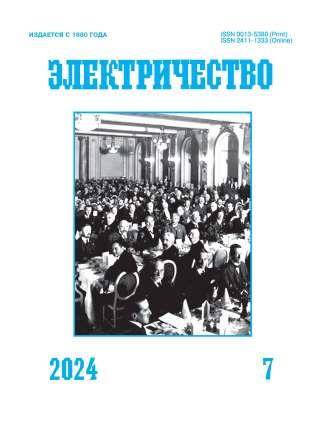Mathematical Modeling of a Horizontal Wind Turbine Control System in the Maximum Power Maintaining Mode
DOI:
https://doi.org/10.24160/0013-5380-2024-7-81-88Keywords:
horizontal axis wind turbine, capacity factor, wind turbine tip speed ratio, power output, maximum power maintenance, renewable energy sourcesAbstract
A mathematical model of a small capacity horizontal axis wind turbine is proposed. A new wind turbine control law based on estimating the generated power by means of an observer is proposed and studied. In this case, feedbacks for the turbine rotation speed and (or) torque on its shaft are excluded. The proposed control law is simple and ensures efficient control of wind generator power at varying turbine rotation speeds and different wind flow velocities. The wind turbine output, aerodynamic and mechanical characteristics have been studied. Speed control for the method of maintaining the maximum power is considered. The obtained dynamic characteristics of the wind wheel rotation speed and torque corresponding to a given wind velocity value confirm the mathematical model adequacy, correct operation of the control system, and its ability to obtain the maximum mechanical power at all permissible wind velocity values. The maximum capacity factor is 0.45 and is achieved at a tip speed ratio of 8.1.
References
2. Peña J.C.U. et al. A Comparative Study of MPPT Strategies and a Novel Single-Phase Integrated Buck-Boost Inverter for Small Wind Energy Conversion Systems. – XI Brazilian Power Electronics Conference, 2011, pp. 458-465, DOI: 10.1109/COBEP.2011.6085307.
3. Mohammed H.J., Korovkin N.V. Prospects for Renewable Energy Sources in Iraq. – Электричество, 2024, № 1, с. 63–68.
4. Thongam J.S., Ouhrouche M. MPPT Control Methods in Wind Energy Conversion Systems. – Fundamental and Advanced Topics in Wind Power, 2011, pp. 339-360, DOI:10.5772/21657.
5. Papatzimos A.K. Data-Driven Operations & Maintenance for Offshore Wind Farms: Tools and Methodologies: Doctoral Thesis. University of Exeter (United Kingdom), 2019.
6. Samokhvalov D.V., Jaber A.I., Almahturi F.S. Maximum Power Point Tracking of a Wind-Energy Conversion System by Vector Control of a Permanent Magnet Synchronous Generator. – Russian Electrical Engineering, 2021, 92(3), pp. 163–168.
7. Blackwood M., Grinshpan A. Maximum Efficiency of a Wind Turbine. – Undergraduate Journal of Mathematical Modeling: One + Two, 2016, 6(2), DOI:10.5038/2326-3652.6.2.4865.
8. Catalogue of European Urban Wind Turbine Manufacturers [Электрон. ресурс], URL http://www.urbanwind.net/pdf/CATALOGUE_V2.pdf (Date of appeal 05.01.2024).
9. El Azzaoui M. Modeling and Control of a Wind System Based Doubly Fed Induction Generator: Optimization of the Power Produced. – Journal of Electrical & Electronic Systems, 2015, 4(1), DOI: 10.4172/2332-0796.1000141.
10. Xia, Y., Ahmed K.H., Williams B. A New Maximum Power Point Tracking Technique for Permanent Magnet Synchronous Generator Based Wind Energy Conversion System. – IEEE Transactions on Power Electronics, 2011, 26(12), pp. 3609–3620, DOI:10.1109/TPEL.2011.2162251.
11. Cace J. et al. Urban Wind Turbines: Guidelines for Small Wind Turbines in the Built Environment, 2007 [Электрон. ресурс], URL: http://www.urbanwind.net/pdf/SMALL_WIND_TURBINES_GUIDE_final.pdf (Date of appeal 05.01.2024).
12. Gipe P. Wind Power: Renewable Energy for Home, Farm, and Business. Chelsea Green Publishing, 2004.
13. Gipe P. Wind Energy Basics: A Guide to Home- and Community-Scale Wind-Energy Systems. Chelsea Green Publishing, 2009, 166 p.
14. Osman M. H., Refaat A., Korovkin N.V. A Novel Method to Extract Single-Diode PV Parameters Based on Datasheet Values. – Электричество, 2021, № 2, с. 16–21.
15. Refaat A., Elgamal M., Korovkin N.V. A Novel Grid-Connected Photovoltaic Centralized Inverter Topology to Improve the Power Harvest during Partial Shading Condition. – Электричество, 2019, № 7, с. 59–68.
#
1. Errami Y., Maaroufi M., Ouassaid M. Modelling and Control Strategy of PMSG Based Variable Speed Wind Energy Conversion System. – International Conference on Multimedia Computing and Systems, 2011, DOI: 10.1109/ICMCS.2011.5945736.
2. Peña J.C.U. et al. A Comparative Study of MPPT Strategies and a Novel Single-Phase Integrated Buck-Boost Inverter for Small Wind Energy Conversion Systems. – XI Brazilian Power Electro-nics Conference, 2011, pp. 458-465, DOI: 10.1109/COBEP.2011.6085307.
3. Mohammed H.J., Korovkin N.V. Elektrichestvo – in Russ. (Electricity), 2024, No. 1, pp. 63–68.
4. Thongam J.S., Ouhrouche M. MPPT Control Methods in Wind Energy Conversion Systems. – Fundamental and Advanced Topics in Wind Power, 2011, pp. 339-360, DOI:10.5772/21657.
5. Papatzimos A.K. Data-Driven Operations & Maintenance for Offshore Wind Farms: Tools and Methodologies: Doctoral Thesis. University of Exeter (United Kingdom), 2019.
6. Samokhvalov D.V., Jaber A.I., Almahturi F.S. Maximum Power Point Tracking of a Wind-Energy Conversion System by Vector Control of a Permanent Magnet Synchronous Generator. – Russian Electrical Engineering, 2021, 92(3), pp. 163–168.
7. Blackwood M., Grinshpan A. Maximum Efficiency of a Wind Turbine. – Undergraduate Journal of Mathematical Modeling: One + Two, 2016, 6(2), DOI:10.5038/2326-3652.6.2.4865.
8. Catalogue of European Urban Wind Turbine Manufacturers [Электрон. ресурс], URL http://www.urbanwind.net/pdf/CATALOGUE_V2.pdf (Date of appeal 05.01.2024).
9. El Azzaoui M. Modeling and Control of a Wind System Based Doubly Fed Induction Generator: Optimization of the Power Produced. – Journal of Electrical & Electronic Systems, 2015, 4(1), DOI: 10.4172/2332-0796.1000141.
10. Xia Y., Ahmed K.H., Williams B. A New Maximum Power Point Tracking Technique for Permanent Magnet Synchronous Generator Based Wind Energy Conversion System. – IEEE Transactions on Power Electronics, 2011, 26(12), pp. 3609–3620, DOI:10.1109/TPEL.2011.2162251.
11. Cace J. et al. Urban Wind Turbines: Guidelines for Small Wind Turbines in the Built Environment, 2007 [Electron. resource], URL: http://www.urbanwind.net/pdf/SMALL_WIND_TURBINES_GUIDE_final.pdf (Date of appeal 05.01.2024).
12. Gipe P. Wind Power: Renewable Energy for Home, Farm, and Business. Chelsea Green Publishing, 2004.
13. Gipe P. Wind Energy Basics: A Guide to Home- and Community-Scale Wind-Energy Systems. Chelsea Green Publishing, 2009, 166 p.
14. Osman M.H., Refaat A., Korovkin N.V. Elektrichestvo – in Russ. (Electricity), 2021, No. 2, pp. 16–21.
15. Refaat A., Elgamal M., Korovkin N.V. Elektrichestvo – in Russ. (Electricity), 2019, No. 7, pp. 59–68




